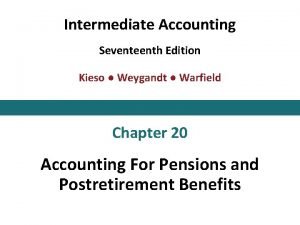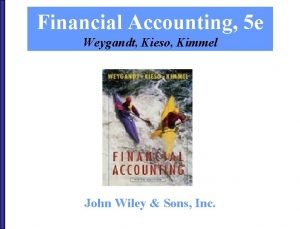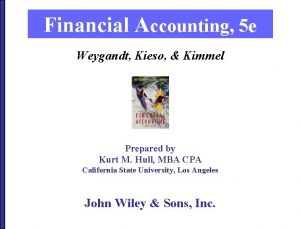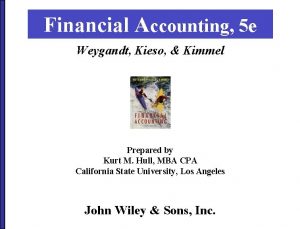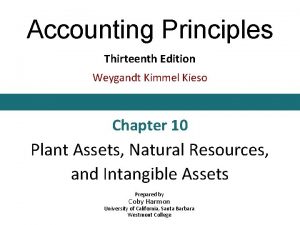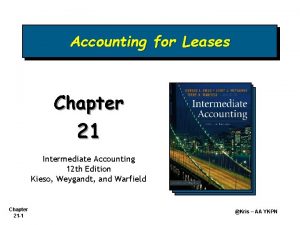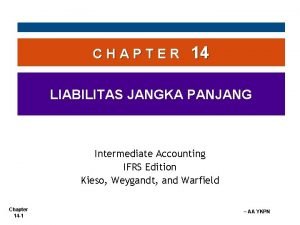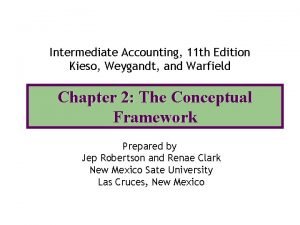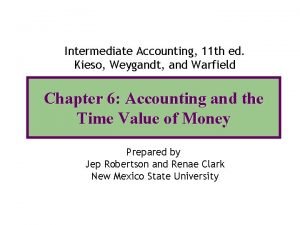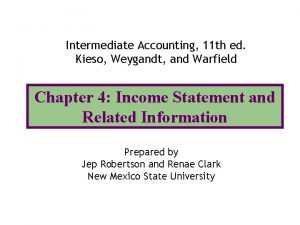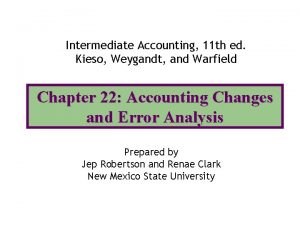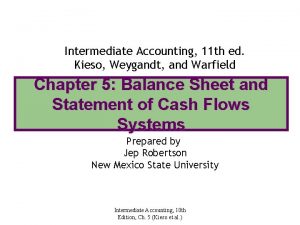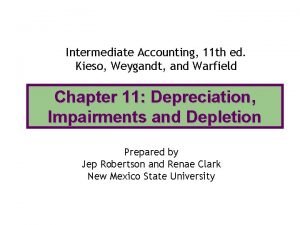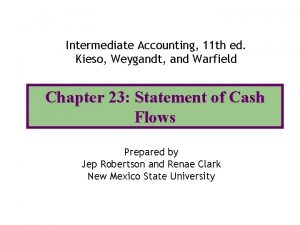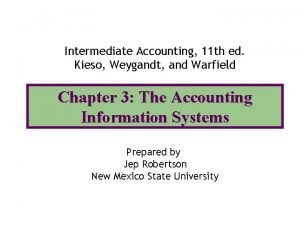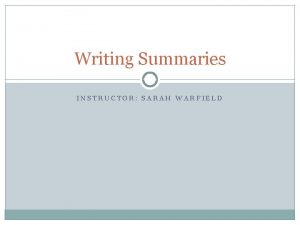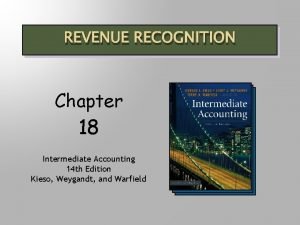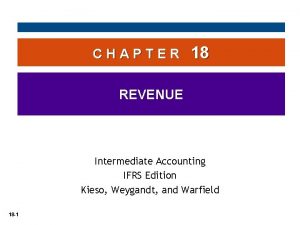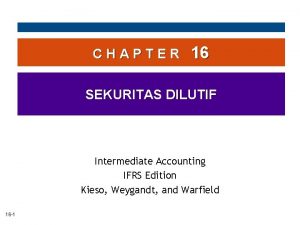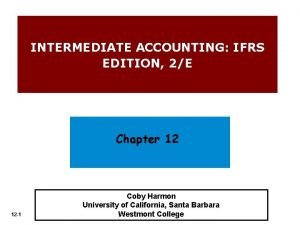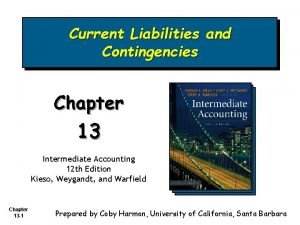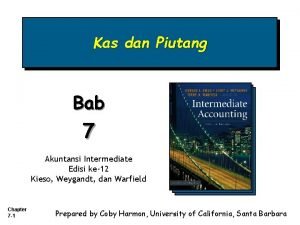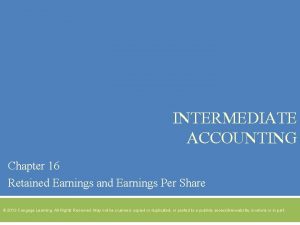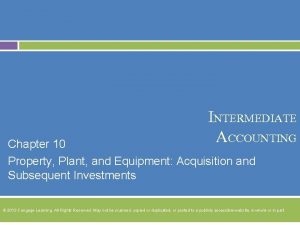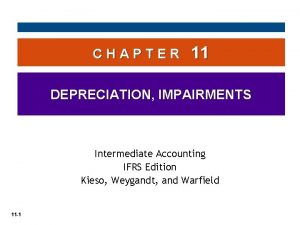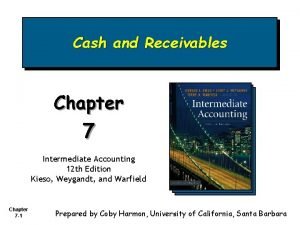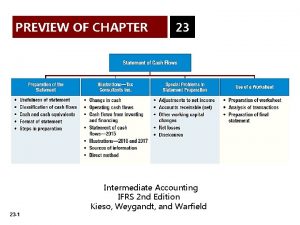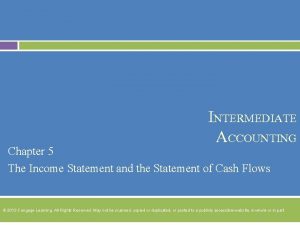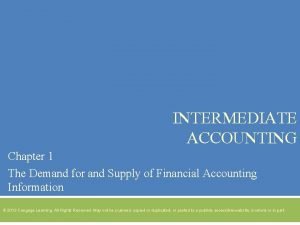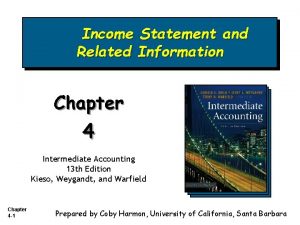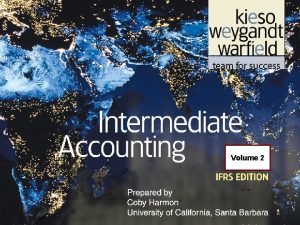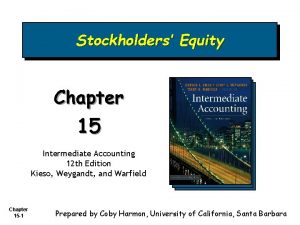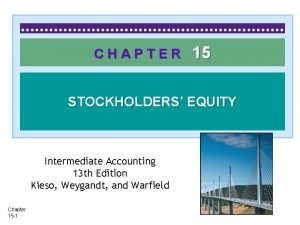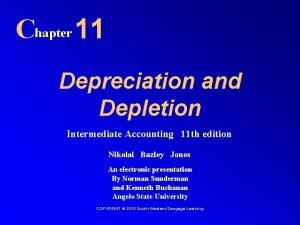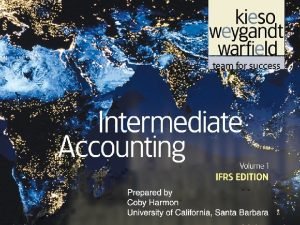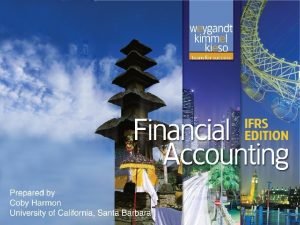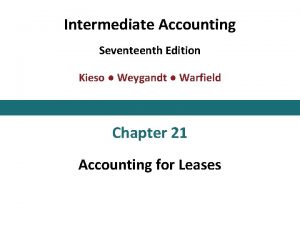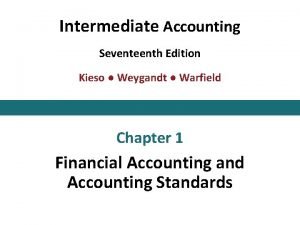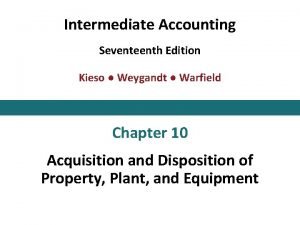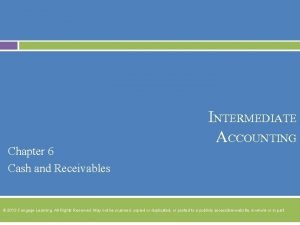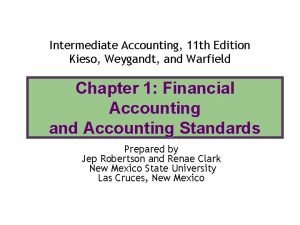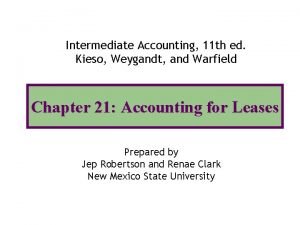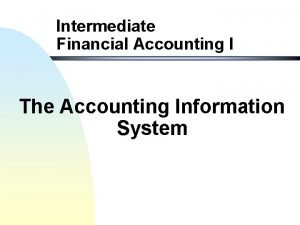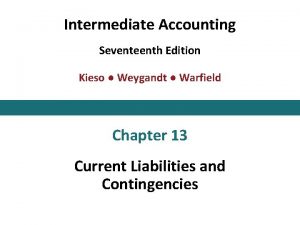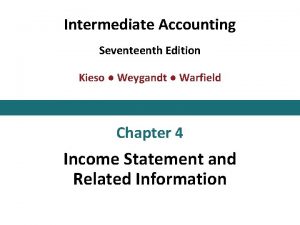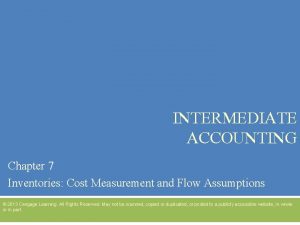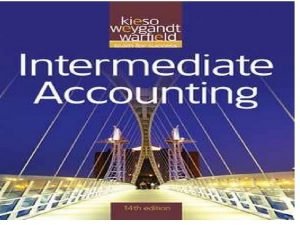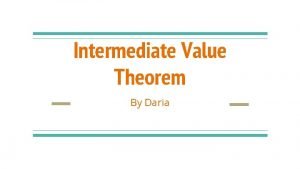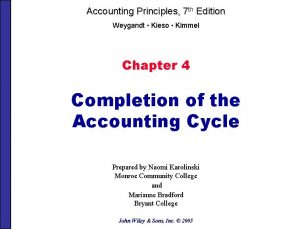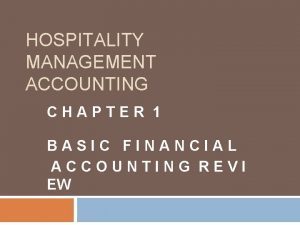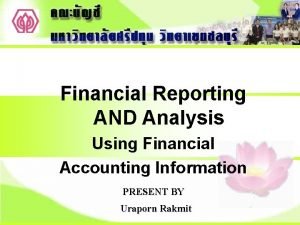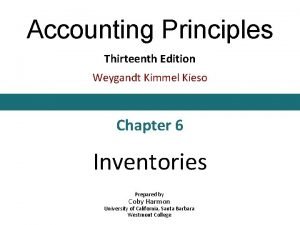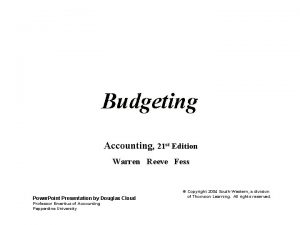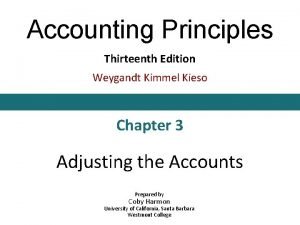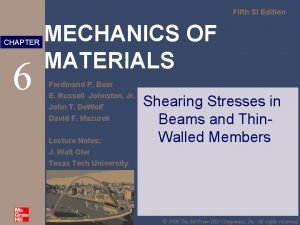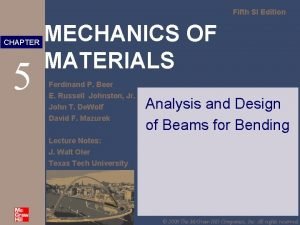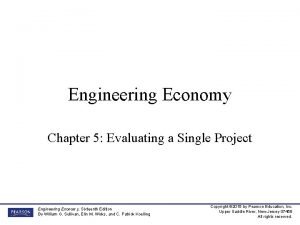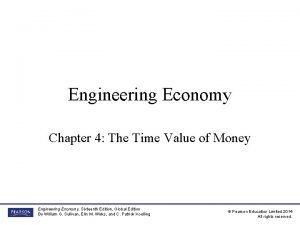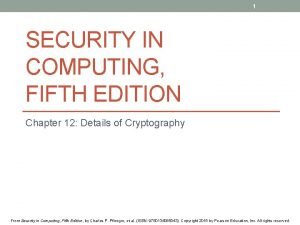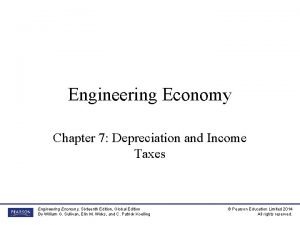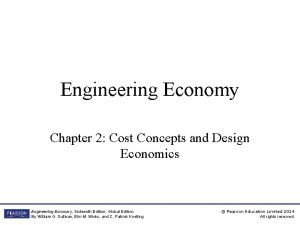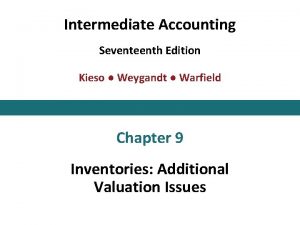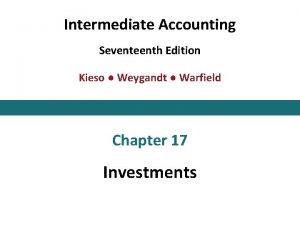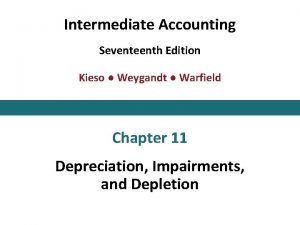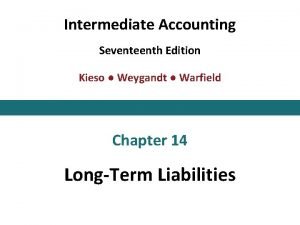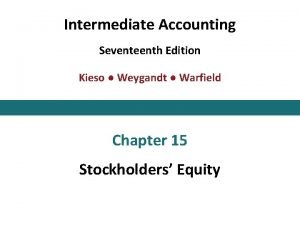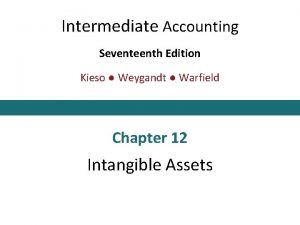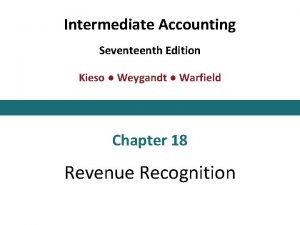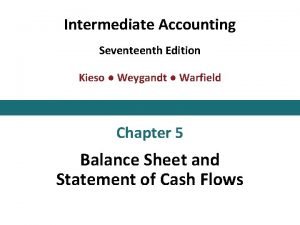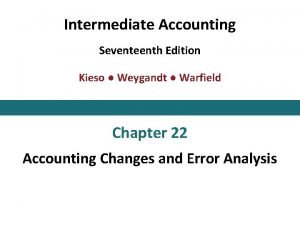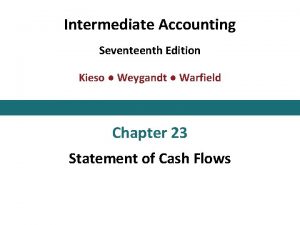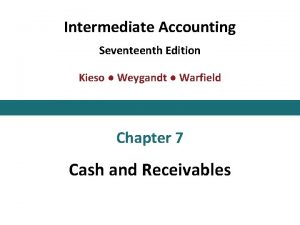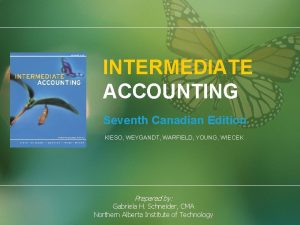Intermediate Accounting Seventeenth Edition Kieso Weygandt Warfield Chapter
























































































































- Slides: 120

Intermediate Accounting Seventeenth Edition Kieso ● Weygandt ● Warfield Chapter 16 Dilutive Securities and Earnings per Share This slide deck contains animations. Please disable animations if they cause issues with your device.

Learning Objectives After studying this chapter, you should be able to: 1. Describe the accounting for the issuance, conversion, and retirement of convertible securities. 2. Contrast the accounting for stock warrants and for stock warrants issued with other securities. 3. Describe the accounting and reporting for stock compensation plans. 4. Compute basic earnings per share. 5. Compute diluted earnings per share. Copyright © 2019 John Wiley & Sons, Inc. 2

Preview of Chapter 16 Dilutive Securities and Earnings Per Share Dilutive Securities • Debt and equity • Convertible debt • Convertible preferred stock Stock Warrants • Warrants and other securities • Stock rights Copyright © 2019 John Wiley & Sons, Inc. 3

Preview of Chapter 16 Stock Compensation Plans • • • Measurement Recognition Restricted stock Employee stock-purchase plans Disclosure of compensation plans Basic Earnings Per Share • Simple structure • Comprehensive example Copyright © 2019 John Wiley & Sons, Inc. 4

Preview of Chapter 16 Diluted Earnings Per Share • • • Convertible securities Options and warrants Contingent issues Antidilution Presentation and disclosure Copyright © 2019 John Wiley & Sons, Inc. 5

Learning Objective 1 Describe the Accounting for the Issuance, Conversion, and Retirement of Convertible Securities LO 1 Copyright © 2019 John Wiley & Sons, Inc. 6

Dilutive Securities Debt and Equity Should companies report these financial instruments as a liability or equity. Stock Options LO 1 Convertible Securities Copyright © 2019 John Wiley & Sons, Inc. Preferred Stock 7

Dilutive Securities Accounting for Convertible Debt Convertible bonds can be changed into other corporate securities during some specified period of time after issuance. LO 1 Copyright © 2019 John Wiley & Sons, Inc. 8

Accounting for Convertible Debt Two main reasons corporations issue convertibles: 1. To raise equity capital without giving up more ownership control than necessary. 2. Obtain debt financing at cheaper rates. The accounting for convertible debt involves reporting issues at the time of (1) issuance, (2) conversion, and (3) retirement. LO 1 Copyright © 2019 John Wiley & Sons, Inc. 9

Accounting for Convertible Debt At Time of Issuance Recording convertible bonds follows the method used to record straight debt issues, with any discount or premium amortized over the term of the debt. Global View IFRS requires that the issuer of convertible debt record the liability and equity components separately. LO 1 Copyright © 2019 John Wiley & Sons, Inc. 10

Accounting for Convertible Debt At Time of Conversion Companies use the book value method when converting bonds. When the debtholder converts the debt to equity, the issuing company recognizes no gain or loss upon conversion. LO 1 Copyright © 2019 John Wiley & Sons, Inc. 11

At Time of Conversion Illustration Hilton, Inc. has a $1, 000 bond that is convertible into 10 shares of common stock (par value $10). At the time of conversion, the unamortized premium is $50. Hilton records the conversion of the bonds as follows. Bonds Payable 1, 000 Premium on Bonds Payable 50 Common Stock Paid-in Capital in Excess of Par—Common LO 1 Copyright © 2019 John Wiley & Sons, Inc. 100 950 12

Accounting for Convertible Debt Induced Conversion • Issuer wishes to encourage prompt conversion. • Issuer offers additional consideration, called a “sweetener. ” • Sweetener is an expense of the current period. LO 1 Copyright © 2019 John Wiley & Sons, Inc. 13

Induced Conversion Illustration: Helloid, Inc. has outstanding $1, 000 par value convertible debentures convertible into 100, 000 shares of $1 par value common stock. Helloid wishes to reduce its annual interest cost. To do so, Helloid agrees to pay the holders of its convertible debentures an additional $80, 000 if they will convert. Assuming conversion occurs, Helloid makes the following entry. Debt Conversion Expense 80, 000 Bonds Payable 1, 000 Common Stock (100, 000 x $1) 100, 000 Paid-in Capital in Excess of Par—Common 900, 000 Cash 80, 000 LO 1 Copyright © 2019 John Wiley & Sons, Inc. 14

Accounting for Convertible Debt Retirement of Convertible Debt • Recognized same as retiring debt that is not convertible. • Difference between the cash acquisition price and carrying amount should be reported as gain or loss in the income statement. LO 1 Copyright © 2019 John Wiley & Sons, Inc. 15

Dilutive Securities Convertible Preferred Stock Convertible preferred stock includes an option for the holder to convert preferred shares into a fixed number of common shares. • Classified as part of stockholders’ equity, unless mandatory redemption exists. • No theoretical justification for recognizing a gain or loss when exercised. • Company uses the book value method. LO 1 Copyright © 2019 John Wiley & Sons, Inc. 16

Convertible Preferred Stock Illustration: Host Enterprises issued 1, 000 shares of common stock (par value $2) upon conversion of 1, 000 shares of preferred stock (par value $1) that was originally issued for a $200 premium. The entry would be: Convertible Preferred Stock (1, 000 × $1) Paid-in Capital in Excess of Par—Preferred Retained Earnings Common Stock (1, 000 x $2) LO 1 Copyright © 2019 John Wiley & Sons, Inc. 1, 000 200 800 2, 000 17

Learning Objective 2 Contrast the Accounting for Stock Warrants and for Stock Warrants Issued with Other Securities LO 2 Copyright © 2019 John Wiley & Sons, Inc. 18

Stock Warrants are certificates entitling the holder to acquire shares of stock at a certain price within a stated period. Normally arises under three situations: 1. To make the security more attractive. 2. Existing stockholders have a preemptive right to purchase common stock first. 3. To executives and employees as a form of compensation. LO 2 Copyright © 2019 John Wiley & Sons, Inc. 19

Stock Warrants Issued with Other Securities Basically long-term options to buy common stock at a fixed price. • Generally life of warrants is five years, occasionally ten years. • Proceeds allocated between the two securities. • Allocation based on fair market values. • Two methods of allocation: 1) proportional method 2) incremental method LO 2 Copyright © 2019 John Wiley & Sons, Inc. 20

Stock Warrants Proportional Method Determine: 1. value of the bonds without the warrants, and 2. value of the warrants. The proportional method allocates the proceeds using the proportion of the two amounts, based on fair values. LO 2 Copyright © 2019 John Wiley & Sons, Inc. 21

Proportional Method Illustration: Assume that AT&T’s bonds (par $1, 000) sold for 99 without the warrants soon after their issue. The market price of the warrants at that time was $30. (Prior to sale the warrants will not have a fair value. ) The allocation relies on an estimate of fair value, generally as established by an investment banker, or on the relative fair value of the bonds and the warrants soon after the company issues and trades them. The price paid for 10, 000, $1, 000 bonds with the warrants attached was par, or $10, 000. The following illustration shows the proportional allocation of the bond proceeds between the bonds and warrants. LO 2 Copyright © 2019 John Wiley & Sons, Inc. 22

Proportional Method Allocation of Proceeds between Bonds and Warrants LO 2 Copyright © 2019 John Wiley & Sons, Inc. 23

Proportional Method Allocation of Proceeds between Bonds and Warrants The bonds sell at a discount. AT&T records the sale as follows. Cash Discount on Bonds Payable 9, 705, 882 294, 118 10, 000 In addition, AT&T sells warrants that it credits to paid-in capital. It makes the following entry. Cash Paid-in Capital—Stock Warrants LO 2 294, 118 Copyright © 2019 John Wiley & Sons, Inc. 294, 118 24

Proportional Method Investors Exercise all 1, 000 Warrants Assuming investors exercise all 10, 000 warrants (one warrant per one share of stock), AT&T makes the following entry. Cash (10, 000 x $25) 250, 000 Paid-in Capital—Stock Warrants 294, 118 Common Stock (10, 000 × $5) Paid-in Capital in Excess of Par—Common 50, 000 494, 118 What if investors fail to exercise the warrants, AT&T debits Paid-in Capital—Stock Warrants for $294, 118 and credits Paidin Capital—Expired Stock Warrants for a like amount. LO 2 Copyright © 2019 John Wiley & Sons, Inc. 25

Stock Warrants Incremental Method Where a company cannot determine the fair value of either the warrants or the bonds. • Use the security for which fair value can determined. • Allocate the remainder of the purchase price to the security for which it does not know fair value. LO 2 Copyright © 2019 John Wiley & Sons, Inc. 26

Incremental Method Illustration: Assume that the fair value of the AT&T warrants is $300, 000, but the company cannot determine the fair value of the bonds without the warrants. The following illustration shows the amount allocated to the warrants and the stock in this case. LO 2 Copyright © 2019 John Wiley & Sons, Inc. 27

Stock Warrants Conceptual Questions Detachable warrants involves two securities, • a debt security, • a warrant to purchase common stock. Nondetachable warrants • do not require an allocation of proceeds between the bonds and the warrants, • companies record the entire proceeds as debt. LO 2 Copyright © 2019 John Wiley & Sons, Inc. 28

Stock Warrants Rights to Subscribe to Additional Shares Stock Right - existing stockholders have the right (preemptive privilege) to purchase newly issued shares in proportion to their holdings. • Price is normally less than current price of the shares. • Companies make only a memorandum entry. LO 2 Copyright © 2019 John Wiley & Sons, Inc. 29

Learning Objective 3 Describe the Accounting and Reporting for Stock Compensation Plans LO 3 Copyright © 2019 John Wiley & Sons, Inc. 30

Stock Compensation Plans Stock Option - gives key employees option to purchase common stock at a given price over extended period of time. Effective compensation programs are ones that: 1. Base compensation on performance. 2. Motivate employees. 3. Help retain executives and recruit new talent. 4. Maximize employee’s after-tax benefit. 5. Use performance criteria over which employee has control. LO 3 Copyright © 2019 John Wiley & Sons, Inc. 31

Stock Compensation Plans Total Executive Pay by Form LO 3 Copyright © 2019 John Wiley & Sons, Inc. 32

Stock Compensation Plans Measurement—Stock Compensation GAAP requires companies to recognize compensation cost using the fair-value method. Under the fair-value method, companies use acceptable option-pricing models to value the options at the date of grant. LO 3 Copyright © 2019 John Wiley & Sons, Inc. 33

Stock Compensation Plans Recognition—Stock Compensation Two main accounting issues: 1. How to determine compensation expense. 2. Over what periods to allocate compensation expense. LO 3 Copyright © 2019 John Wiley & Sons, Inc. 34

Recognition—Stock Compensation Determining Expense • Compensation expense based on the fair value of the options expected to vest on the date they grant the options to the employee(s) (i. e. , the grant date). Allocating Compensation Expense • Recognizes compensation expense in the periods in which its employees perform the service—the service period. LO 3 Copyright © 2019 John Wiley & Sons, Inc. 35

Stock Compensation Example Illustration: On November 1, 2019, the stockholders of Chen Company approve a plan that grants the company’s five executives options to purchase 2, 000 shares each of the company’s $1 par value common stock. The company grants the options on January 1, 2020. The executives may exercise the options at any time within the next 10 years. The option price per share is $60, and the market price of the stock at the date of grant is $70 per share. Under the fair value method, the company computes total compensation expense by applying an acceptable fair value optionpricing model (Black-Scholes). To keep this illustration simple, we assume that the fair value option-pricing model determines Chen’s total compensation expense to be $220, 000. LO 3 Copyright © 2019 John Wiley & Sons, Inc. 36

Stock Compensation Example Basic Entries. Assume that the expected period of benefit is two years, starting with the grant date. Chen would record the transactions related to this option contract as follows. Dec. 31, 2020 Compensation Expense Paid-in Capital – Stock Options Dec. 31, 2021 Compensation Expense Paid-in Capital - Stock Options * ($220, 000 ÷ 2) LO 3 110, 000 * 110, 000 Copyright © 2019 John Wiley & Sons, Inc. 110, 000 37

Stock Compensation Example Exercise If Chen’s executives exercise 2, 000 of the 10, 000 options (20 percent of the options) on June 1, 2023 (three years and five months after date of grant), the company records the following journal entry. June 1, 2023 120, 000 Cash (2, 000 × $60) 44, 000 Paid-in Capital - Stock Options 2, 000 Common Stock (2, 000 × $1) 162, 000 Paid-in Capital in Excess of Par - Common LO 3 Copyright © 2019 John Wiley & Sons, Inc. 38

Stock Compensation Example Expiration If Chen’s executives fail to exercise the remaining stock options before their expiration date, the company transfers the balance in the Paid-in Capital—Stock Options account to a more properly titled paid-in capital account, such as Paid-in Capital—Expired Stock Options. Chen records this transaction at the date of expiration as follows. January 1, 2030 Paid-in Capital - Stock Options Paid-in Capital—Expired Stock Options * ($220, 000 × 80%) LO 3 Copyright © 2019 John Wiley & Sons, Inc. 176, 000 * 176, 000 39

Stock Compensation Example Adjustment A company does not adjust compensation expense upon expiration of the options. However, if an employee forfeits a stock option because the employee fails to satisfy a service requirement (e. g. , leaves employment), the company should adjust the estimate of compensation expense recorded in the current period (as a change in estimate). LO 3 Copyright © 2019 John Wiley & Sons, Inc. 40

Restricted Stock Restricted-stock plans transfer shares of stock to employees, subject to an agreement that shares cannot be sold, transferred, or pledged until vesting occurs. Major Advantages: 1. Never becomes completely worthless. 2. Generally results in less dilution to existing stockholders. 3. Better aligns employee incentives with company incentives. LO 3 Copyright © 2019 John Wiley & Sons, Inc. 41

Restricted Stock Example Illustration: On January 1, 2020, Ogden Company issues 1, 000 shares of restricted stock to its CEO, Christie De. George. Ogden’s stock has a fair value of $20 per share on January 1, 2020. Additional information is as follows. 1. The service period related to the restricted stock is five years. 2. Vesting occurs if De. George stays with the company for a five-year period. 3. The par value of the stock is $1 per share. LO 3 Copyright © 2019 John Wiley & Sons, Inc. 42

Restricted Stock Example January 1, 2020 Ogden makes the following entry on the grant date (January 1, 2020). 20, 000 Unearned Compensation Common Stock (1, 000 × $1) Paid-in Capital in Excess of Par - Common 1, 000 19, 000 Unearned Compensation represents the cost of services yet to be performed, which is not an asset. Unearned Compensation is reported as a component of stockholders’ equity in the balance sheet. LO 3 Copyright © 2019 John Wiley & Sons, Inc. 43

Restricted Stock Example December 31, 2020 At December 31, 2020, Ogden records compensation expense of $4, 000 (1, 000 shares × $20 ×. 20) as follows. Compensation Expense Unearned Compensation 4, 000 Ogden records compensation expense of $4, 000 for each of the next four years (2021, 2022, 2023, and 2024). LO 3 Copyright © 2019 John Wiley & Sons, Inc. 44

Restricted Stock Example February 3, 2022 Assume that De. George leaves on February 3, 2022 (before any expense has been recorded during 2022). The entry to record this forfeiture is as follows. Common Stock (1, 000 x $1) Paid-in Capital in Excess of Par—Common Compensation Expense ($4, 000 x 2) Unearned Compensation LO 3 Copyright © 2019 John Wiley & Sons, Inc. 1, 000 19, 000 8, 000 12, 000 45

Stock Compensation Plans Employee Stock-Purchase Plans • Generally permit all employees to purchase stock at a discounted price for a short period of time. • Plans are considered compensatory unless they satisfy all three conditions presented below. 1. Substantially all full-time employees may participate on an equitable basis. 2. The discount from market is small. 3. The plan offers no substantive option feature. LO 3 Copyright © 2019 John Wiley & Sons, Inc. 46

Stock Compensation Plans Disclosure of Compensation Plans Company with one or more share-based payment arrangements must disclose: 1. Nature and extent of such arrangements. 2. Effect on the income statement of compensation cost. 3. Method of estimating the fair value of the goods or services received, or the fair value of the equity instruments granted (or offered to grant). 4. Cash flow effects. LO 3 Copyright © 2019 John Wiley & Sons, Inc. 47

Learning Objective 4 Compute Basic Earnings Per Share LO 4 Copyright © 2019 John Wiley & Sons, Inc. 48

Basic Earnings Per Share Income Statement Presentation of EPS Earnings per share indicates the income earned by each share of common stock. Companies report earnings per share only for common stock. Net income Earnings per share LO 4 $300, 000 $3. 00 Copyright © 2019 John Wiley & Sons, Inc. 49

Basic Earnings Per Share Income Statement Presentation of EPS Components Earnings per share indicates the income earned by each share of common stock. When the income statement contains intermediate components, such as discontinued operations, companies should disclose earnings per share for each component. Earnings per share: Income from continuing operations Loss from discontinued operations, net of tax Net income LO 4 Copyright © 2019 John Wiley & Sons, Inc. $4. 00 0. 60 $3. 40 50

Basic Earnings Per Share Earnings per Share—Simple Capital Structure • Simple Structure--Common stock; no potentially dilutive securities. • Complex Structure--Includes securities that could dilute earnings per common share. • “Dilutive” means the ability to influence the EPS in a downward direction. LO 4 Copyright © 2019 John Wiley & Sons, Inc. 51

Basic Earnings Per Share Preferred Stock Dividends Subtracts the current-year preferred stock dividend from net income to arrive at income available to common stockholders. Preferred dividends are subtracted on cumulative preferred stock, whether declared or not. LO 4 Copyright © 2019 John Wiley & Sons, Inc. 52

Basic Earnings Per Share Weighted-Average Number of Shares Outstanding Companies must weight the shares by the fraction of the period they are outstanding. When stock dividends or share splits occur, companies need to restate the shares outstanding before the share dividend or split. LO 4 Copyright © 2019 John Wiley & Sons, Inc. 53

Weighted-Average Shares Outstanding Illustration: Franks Inc. has the following changes in its common stock during the period. Date January 1 April 1 Share Changes Beginning balance Issued 30, 000 shares for cash July 1 Purchased 39, 000 shares November 1 December 31 Issued 60, 000 shares for cash Ending balance Shares Outstanding 90, 000 30, 000 120, 000 (39, 000) 81, 000 60, 000 141, 000 Compute the weighted-average number of shares outstanding. LO 4 Copyright © 2019 John Wiley & Sons, Inc. 54

Weighted-Average Shares Outstanding Weighted-Average Number of Shares Outstanding (A) Shares Outstanding (B) Fraction of Year Jan. 1 -Apr. 1 -July 1 90, 000 120, 000 3/12 22, 500 30, 000 July 1 -Nov. 1 81, 000 4/12 27, 000 Dates Outstanding Nov. 1 -Dec. 31 141, 000 2/12 Weighted-average number of shares outstanding LO 4 (C) Weighted Shares (A × B) Copyright © 2019 John Wiley & Sons, Inc. 23, 500 103, 000 55

Weighted-Average Shares Outstanding Stock Dividends and Stock Splits • When stock dividends or stock splits occur, companies need to restate the shares outstanding before the stock dividend or split, in order to compute the weighted-average number of shares. • Companies restate the issuance of a stock dividend or stock split, but not the issuance or repurchase of stock for cash. LO 4 Copyright © 2019 John Wiley & Sons, Inc. 56

Stock Dividends and Stock Splits Illustration: Sabrina Company has the following changes in its common stock during the period. Date January 1 March 1 Share Changes Beginning balance Issued 20, 000 shares for cash June 1 60, 000 additional shares (50% stock dividend) November 1 December 31 Issued 30, 000 shares for cash Ending balance LO 4 Copyright © 2019 John Wiley & Sons, Inc. Shares Outstanding 100, 000 20, 000 120, 000 60, 000 180, 000 30, 000 210, 000 57

Stock Dividends and Stock Splits Weighted-Average Share Calculation Dates Outstanding (A) Shares (B) Outstanding Restatement 2/12 3/12 25, 000 45, 000 5/12 75, 000 Nov. 1 -Dec. 31 210, 000 2/12 Weighted-average number of shares outstanding 35, 000 180, 000 LO 4 Jan. 1 -Mar. 1 -June 1 100, 000 120, 000 June 1 -Nov. 1 180, 000 1. 50 (C) Fraction of Year (D) Weighted Shares (A × B x C) Copyright © 2019 John Wiley & Sons, Inc. 58

Learning Objective 5 Compute Diluted Earnings Per Share LO 5 Copyright © 2019 John Wiley & Sons, Inc. 59

Diluted Earnings Per Share Complex Capital Structure exists when a business has • convertible securities, • options, warrants, or other rights that upon conversion or exercise could dilute earnings per share. Company generally reports both basic and diluted earnings per share. LO 5 Copyright © 2019 John Wiley & Sons, Inc. 60

Diluted Earnings Per Share Relationship Between Basic and Diluted EPS Companies will not report diluted EPS if the securities in their capital structure antidilutive. LO 5 Copyright © 2019 John Wiley & Sons, Inc. 61

Diluted EPS — Convertible Securities Measure the dilutive effects of potential conversion on EPS using the if-converted method. This method for a convertible bond assumes: 1. the conversion at the beginning of the period (or at the time of issuance of the security, if issued during the period), and 2. the elimination of related interest, net of tax. LO 5 Copyright © 2019 John Wiley & Sons, Inc. 62

Example — If-Converted Method Illustration: Mayfield Corporation has net income of $210, 000 for the year and a weighted-average number of common shares outstanding during the period of 100, 000 shares. The company has two convertible debenture bond issues outstanding. One is a 6 percent issue sold at 100 (total $1, 000) in a prior year and convertible into 30, 000 common shares. The other is a 10 percent issue sold at 100 (total $1, 000) on April 1 of the current year and convertible into 36, 000 common shares. The tax rate is 20 percent. LO 5 Copyright © 2019 John Wiley & Sons, Inc. 63

Example — If-Converted Method Basic Earnings per Share Calculate basic earnings per share. Net income = $210, 000 Weighted-average shares = 100, 000 LO 5 Copyright © 2019 John Wiley & Sons, Inc. = $2. 10 64

Example — If-Converted Method Computation of Weighted-Average Number of Shares Mayfield calculates the weighted-average number of shares outstanding, as follows. Weighted-average number of shares outstanding 100, 000 Add: Shares assumed to be issued: 6% debentures (as of beginning of year) 30, 000 10% debentures (as of date of issue, April 1; 9/12 x 36, 000) 27, 000 Weighted-average number of shares adjusted for dilutive securities 157, 000 Calculate diluted earnings per share. LO 5 Copyright © 2019 John Wiley & Sons, Inc. 65

Example — If-Converted Method Diluted EPS Calculation Basic EPS 6% Debentures 10% Debentures $210, 000 + $60, 000 x (1 -. 20) + $100, 000 x (1 -. 20) x 9/12 100, 000 Basic EPS = $2. 10 + 30, 000 Effect on EPS = $1. 60 27, 000 + = Effect on EPS = $2. 22 Diluted EPS = $2. 03 LO 5 Copyright © 2019 John Wiley & Sons, Inc. 66

Example — If-Converted Method Other Factors The conversion rate on a dilutive security may change during the period in which the security is outstanding. In this situation, the company uses the most dilutive conversion rate available. For Convertible Preferred Stock the company does not subtract preferred dividends from net income in computing the numerator. Why not? Because for purposes of computing EPS, it assumes conversion of the convertible preferreds to outstanding common shares. LO 5 Copyright © 2019 John Wiley & Sons, Inc. 67

If-Converted Method Additional Example In 2019, Chirac Enterprises issued, at par, 60, $1, 000, 8% bonds, each convertible into 100 shares of common stock. Chirac had revenues of $17, 500 and expenses other than interest and taxes of $8, 400 for 2020. (Assume that the tax rate is 40%. ) Throughout 2020, 2, 000 shares of common stock were outstanding; none of the bonds was converted or redeemed. Instructions a. Compute diluted earnings per share for 2020. b. Assume same facts as those for Part (a), except the 60 bonds were issued on September 1, 2020 (rather than in 2019), and none have been converted or redeemed. LO 5 Copyright © 2019 John Wiley & Sons, Inc. 68

If-Converted Method Computation of Net Income a. Compute diluted earnings per share for 2020. Calculation of Net Income LO 5 Revenues Expenses Bond interest expense (60 × $1, 000 × 8%) Income before taxes $17, 500 8, 400 4, 800 4, 300 Income tax expense (40%) Net income 1, 740 $ 2, 580 Copyright © 2019 John Wiley & Sons, Inc. 69

If-Converted Method Basic EPS a. Compute diluted earnings per share for 2020. When calculating Diluted EPS, begin with basic EPS. Net income = $2, 580 Weighted-average shares = 2, 000 LO 5 Copyright © 2019 John Wiley & Sons, Inc. = $1. 29 70

If-Converted Method Diluted EPS a. Compute diluted earnings per share for 2020. When calculating Diluted EPS, begin with basic EPS. $2, 580 + 2, 000 Basic EPS = $1. 29 LO 5 + $4, 800 (1 -. 40) 6, 000 = $5, 460 8, 000 = $. 68 Effect on EPS = $. 48 Copyright © 2019 John Wiley & Sons, Inc. 71

If-Converted Method Computation of Net Income Sept. 1, 2020 b. Assume bonds were issued on Sept. 1, 2020. Calculation of Net Income Revenues $17, 500 Expenses 8, 400 Bond interest expense (60 × $1, 000 × 8% x 4/12) 1, 600 Income before taxes 7, 500 Income tax expense (40%) Net income LO 5 Copyright © 2019 John Wiley & Sons, Inc. 3, 000 $ 4, 500 72

If-Converted Method Diluted EPS Bonds Issued Sept. 1, 2020 a. Compute diluted earnings per share for 2020. When calculating Diluted EPS, begin with basic EPS. $4, 500 + 2, 000 Basic EPS = $2. 25 LO 5 + $1, 600 (1 -. 40) 6, 000 x 4/12 = $5, 460 4, 000 = $1. 37 Effect on EPS = $. 48 Copyright © 2019 John Wiley & Sons, Inc. 73

If-Converted Method Convertible Preferred Stock Illustration: Prior to 2020, Barkley Company issued 40, 000 shares of 6% convertible, cumulative preferred stock, $100 par value. Each share is convertible into 5 shares of common stock. Net income for 2020 was $1, 200, 000. There were 600, 000 common shares outstanding during 2020. There were no changes during 2020 in the number of common or preferred shares outstanding. Instructions a. Compute diluted earnings per share for 2020. LO 5 Copyright © 2019 John Wiley & Sons, Inc. 74

Convertible Preferred Stock Basic EPS a. Compute diluted earnings per share for 2020. When calculating Diluted EPS, begin with basic EPS. Net income = $1, 200, 000 – Pfd. Div. $240, 000 Weighted-average shares = 600, 000 = $1. 60 40, 000 shares × $100 par × 6% = $240, 000 dividend LO 5 Copyright © 2019 John Wiley & Sons, Inc. 75

Convertible Preferred Stock Diluted EPS a. Compute diluted earnings per share for 2020. When calculating Diluted EPS, begin with basic EPS. $1, 200, 000 – $240, 000 + $240, 000 600, 000 + 200, 000 * = $1, 200, 000 800, 000 = $1. 50 Basic EPS = $1. 60 LO 5 Effect on EPS = $1. 20 Copyright © 2019 John Wiley & Sons, Inc. * (40, 000 x 5) 76

Convertible Preferred Stock Diluted EPS – 3 Common Shares for 1 Preferred Share b. Compute diluted earnings per share for 2020 assuming each share of preferred is convertible into 3 shares of common stock. $1, 200, 000 – $240, 000 + $240, 000 600, 000 + 120, 000* = $1, 200, 000 720, 000 = $1. 67 Basic EPS = $1. 60 LO 5 Effect on EPS = $2. 00 Copyright © 2019 John Wiley & Sons, Inc. * (40, 000 x 3) 77

Convertible Preferred Stock Diluted EPS – 3 Common Shares for 1 Preferred Share b. Compute diluted earnings per share for 2020 assuming each share of preferred is convertible into 3 shares of common stock. $1, 200, 000 – $240, 000 + $240, 000 600, 000 + 120, 000* Antidilutive Basic EPS = $1. 60 LO 5 Effect on EPS = $2. 00 Copyright © 2019 John Wiley & Sons, Inc. = $1, 200, 000 720, 000 = $1. 60 * (40, 000 x 3) 78

Diluted EPS– Options and Warrants Measure the dilutive effects of potential conversion using the treasury-stock method. This method assumes: 1. the exercise the options or warrants at the beginning of the year (or date of issue if later), and 2. that the company uses those proceeds to purchase common stock for the treasury. LO 5 Copyright © 2019 John Wiley & Sons, Inc. 79

Example — Treasury-Stock Method Illustration: Zambrano Company’s net income for 2020 is $40, 000. The only potentially dilutive securities outstanding were 1, 000 options issued during 2019, each exercisable for one share at $8. None has been exercised, and 10, 000 shares of common were outstanding during 2020. The average market price of the stock during 2020 was $20. Instructions a. Compute diluted earnings per share. b. Assume the 1, 000 options were issued on October 1, 2020 (rather than in 2019). The average market price during the last 3 months of 2020 was $20. LO 5 Copyright © 2019 John Wiley & Sons, Inc. 80

Treasury-Stock Method Incremental Share Calculation Proceeds if shares issued (1, 000 × $8) Purchase price for treasury shares Shares assumed purchased Shares assumed issued Incremental share increase LO 5 Copyright © 2019 John Wiley & Sons, Inc. $8, 000 ÷ $20 400 1, 000 600 81

Treasury-Stock Method Diluted EPS $40, 000 + 10, 000 + Basic EPS = $4. 00 LO 5 600 = $40, 000 10, 600 = $3. 77 Options Copyright © 2019 John Wiley & Sons, Inc. 82

Treasury-Stock Method Incremental Shares – Options Issued October 1, 2020 a. Assume the 1, 000 options were issued on October 1, 2020 (rather than in 2019). The average market price during the last 3 months of 2020 was $20. Proceeds if shares issued (1, 000 × $8) Purchase price for treasury shares Shares assumed purchased Shares assumed issued Incremental share increase Weight for 3 months assumed outstanding Weighted incremental share increase LO 5 Copyright © 2019 John Wiley & Sons, Inc. $ 8, 000 ÷ $ 20 400 1, 000 600 x 3/12 150 83

Treasury-Stock Method Diluted EPS – Options Issued October 31, 2020 a. Assume the 1, 000 options were issued on October 1, 2020 (rather than in 2019). The average market price during the last 3 months of 2020 was $20. $40, 000 10, 000 Basic EPS = $4. 00 LO 5 + 150 = $40, 000 10, 150 = $3. 94 Options Copyright © 2019 John Wiley & Sons, Inc. 84

Diluted Earnings Per Share Contingent Issue Agreement Contingent shares are issued as a result of the 1. passage of time condition or 2. upon attainment of a certain earnings or market price level. Antidilution Revisited Ignore antidilutive securities in all calculations and in computing diluted earnings per share. LO 5 Copyright © 2019 John Wiley & Sons, Inc. 85

Diluted Earnings Per Share EPS Presentation and Disclosure A company should show per share amounts for: • Income from continuing operations, • Income before extraordinary items, and • Net income. Per share amounts for a discontinued operation or an extraordinary item should be presented on the face of the income statement or in the notes. LO 5 Copyright © 2019 John Wiley & Sons, Inc. 86

EPS Presentation and Disclosure Complex capital structures and dual presentation of EPS require the following additional disclosures in note form. 1. Description of pertinent rights and privileges of the various securities outstanding. 2. A reconciliation of the numerators and denominators of the basic and diluted per share computations, including individual income and share amount effects of all securities that affect EPS. 3. The effect given preferred dividends in determining income available to common stockholders in computing basic EPS. 4. Securities that could potentially dilute basic EPS in the future that were excluded in the computation because they would be antidilutive. 5. Effect of conversions subsequent to year-end, but before issuing statements. LO 5 Copyright © 2019 John Wiley & Sons, Inc. 87

Summary of EPS LO 5 Copyright © 2019 John Wiley & Sons, Inc. 88

Calculating EPS Complex Capital Structure LO 5 Copyright © 2019 John Wiley & Sons, Inc. 89

Learning Objective 6 Explain the Accounting for Stock. Appreciation Rights Plans LO 6 Copyright © 2019 John Wiley & Sons, Inc. 90

Appendix 16 A: Accounting for Stock- Appreciation Rights • Company gives an executive the right to receive compensation equal to the share appreciation. • Share appreciation is the excess of the market price of the stock at the date of exercise over a pre-established price. • Company may pay the share appreciation in cash, shares, or a combination of both. • Accounting for stock-appreciation rights depends on whether the company classifies the rights as equity or as a liability. LO 6 Copyright © 2019 John Wiley & Sons, Inc. 91

SARS — Share-Based Equity Awards Companies classify SARs as equity awards if at the date of exercise, the holder receives shares of stock from the company upon exercise. • Holder receives shares in an amount equal to the shareprice appreciation (the difference between the market price and the pre-established price). • At the date of grant, the company determines a fair value for the SAR and then allocates this amount to compensation expense over the service period of the employees. LO 6 Copyright © 2019 John Wiley & Sons, Inc. 92

SARS — Share-Based Liability Awards Companies classify SARs as liability awards if at the date of exercise, the holder receives a cash payment. To record sharebased liability: 1. Measure the fair value of the award at the grant date and accrue compensation over the service period. 2. Remeasure the fair value each reporting period, until the award is settled; adjust the compensation cost each period for changes in fair value prorated for the portion of the service period completed. 3. Once the service period is completed, determine compensation expense each subsequent period by reporting the full change in market price as an adjustment to compensation expense. LO 6 Copyright © 2019 John Wiley & Sons, Inc. 93

Stock-Appreciation Rights Example Illustration: American Hotels, Inc. establishes a stockappreciation rights plan on January 1, 2020. The plan entitles executives to receive cash at the date of exercise for the difference between the market price of the stock and the preestablished price of $10 on 10, 000 SARs. The fair value of the SARs on December 31, 2020, is $3, and the service period runs for two years (2020 -2021). The following illustration indicates the amount of compensation expense to be recorded each period. LO 6 Copyright © 2019 John Wiley & Sons, Inc. 94

Stock-Appreciation Rights Example Compensation Expense Compensation expense in the first year. Compensation Expense Liability under Stock-Appreciation Plan LO 6 Copyright © 2017 John Wiley & Sons, Inc. 15, 000 34

Stock-Appreciation Rights Example Accounting in 2022 In 2022, when it records negative compensation expense, American would debit the account for $20, 000. The entry to record the negative compensation expense is as follows. Liability under Stock-Appreciation Plan Compensation Expense 20, 000 At December 31, 2022, the executives receive $50, 000. American would remove the liability with the following entry. Liability under Stock-Appreciation Plan Cash LO 6 Copyright © 2019 John Wiley & Sons, Inc. 50, 000 96

Learning Objective 7 Compute Earnings Per Share in a Complex Situation LO 7 Copyright © 2019 John Wiley & Sons, Inc. 97

Appendix 16 B: Comprehensive Earnings Per Share Example LO 7 Copyright © 2019 John Wiley & Sons, Inc. 98

Comprehensive EPS Example Notes and Assumptions December 31, 2020 1. Options were granted in July 2018 to purchase 50, 000 shares of common stock at $20 per share. The average market price of common stock during 2020 was $30 per share. All options are still outstanding at the end of 2020. 2. Both the 8 percent and 10 percent convertible bonds were issued in 2019 at face value. Each convertible bond is convertible into 40 shares of common stock. (Each bond has a face value of $1, 000. ) 3. The 7 percent cumulative, convertible preferred stock was issued at the beginning of 2020 at par. Each share of preferred is convertible into two shares of common stock. 4. The average income tax rate is 20 percent. 5. 500, 000 shares of common stock were outstanding during the entire year. 6. Preferred dividends were not declared in 2020. 7. Net income was $1, 750, 000 in 2020. 8. No bonds or preferred stock were converted during 2020. LO 7 Copyright © 2019 John Wiley & Sons, Inc. 99

Comprehensive EPS Example Computation of Earnings per Share—Simple Capital Structure Net income $1, 750, 000 Less: 10% cumulative, convertible preferred stock dividend requirements Income applicable to common stockholders Weighted-average number of common shares outstanding Earnings per common share LO 7 Copyright © 2019 John Wiley & Sons, Inc. 250, 000 $1, 500, 000 $3. 00 100

Comprehensive EPS Example Diluted Earnings per Share Steps for computing diluted earnings per share: 1. Determine, for each dilutive security, the per share effect assuming exercise/conversion. 2. Rank the results from step 1 from smallest to largest earnings effect per share. 3. Beginning with the earnings per share based upon the weighted -average of common stock outstanding, recalculate earnings per share by adding the smallest per share effects from step 2. Continue this process so long as each recalculated earnings per share is smaller than the previous amount. LO 7 Copyright © 2019 John Wiley & Sons, Inc. 101

Diluted Earnings per Share The first step is to determine a per share effect for each potentially dilutive security. LO 7 Copyright © 2019 John Wiley & Sons, Inc. 102

Diluted Earnings per Share Per Share Effect of Options (Treasury-Stock Method), Diluted Earnings per Share LO 7 Copyright © 2019 John Wiley & Sons, Inc. 103

Diluted Earnings per Share Per Share Effect of 8% Bonds (If-Converted Method), Diluted Earnings per Share LO 7 Copyright © 2019 John Wiley & Sons, Inc. 104

Diluted Earnings per Share Per Share Effect of 10% Bonds (If-Converted Method), Diluted Earnings per Share LO 7 Copyright © 2019 John Wiley & Sons, Inc. 105

Diluted Earnings per Share Per Share Effect of 7% Convertible Preferred (If. Converted Method), Diluted Earnings per Share LO 7 Copyright © 2019 John Wiley & Sons, Inc. 106

Diluted Earnings per Share Ranking of per Share Effects (Smallest to Largest), Diluted Earnings per Share Effect per Share 1. Options 2. 8% convertible bonds 3. 10% convertible bonds 4. 10% convertible preferred LO 7 $0 1. 60 2. 00 3. 50 Copyright © 2019 John Wiley & Sons, Inc. 107

Diluted Earnings per Share Recomputation of EPS Using Incremental Effect of Options The next step is to determine earnings per share giving effect to the ranking. LO 7 Copyright © 2019 John Wiley & Sons, Inc. 108

Diluted Earnings per Share Recomputation of EPS Using Incremental Effect of 8% Convertible Bonds LO 7 Copyright © 2019 John Wiley & Sons, Inc. 109

Diluted Earnings per Share Recomputation of EPS Using Incremental Effect of 10% Convertible Bonds LO 7 Copyright © 2019 John Wiley & Sons, Inc. 110

Diluted Earnings per Share Recomputation of EPS Using Incremental Effect of 7% Convertible Preferred LO 7 Copyright © 2019 John Wiley & Sons, Inc. 111

Diluted Earnings per Share Income Statement Presentation, EPS LO 7 Copyright © 2019 John Wiley & Sons, Inc. 112

Diluted Earnings per Share Barton Company Data Assume that Barton Company provides the following information. LO 7 Copyright © 2019 John Wiley & Sons, Inc. 113

Diluted Earnings per Share Barton Company Basic and Diluted EPS LO 7 Copyright © 2019 John Wiley & Sons, Inc. 114

Learning Objective 8 Compare the Accounting for Dilutive Securities and Earnings Per Share Under GAAP and IFRS LO 8 Copyright © 2019 John Wiley & Sons, Inc. 115

IFRS Insights Relevant Facts – Similarities • IFRS and GAAP follow the same model for recognizing stock-based compensation: The fair value of shares and options awarded to employees is recognized over the period to which the employees’ services relate. • Although the calculation of basic and diluted earnings per share is similar between IFRS and GAAP, the Boards are working to resolve the few minor differences in EPS reporting. One proposal in the FASB project concerns contracts that can be settled in either cash or shares. IFRS requires that share settlement must be used, while GAAP gives companies a choice. The FASB project proposes adopting the IFRS approach, thus converging IFRS and GAAP in this regard. LO 8 Copyright © 2019 John Wiley & Sons, Inc. 116

IFRS Insights Relevant Facts – Differences • A significant difference between IFRS and GAAP is the accounting for securities with characteristics of debt and equity, such as convertible debt. Under GAAP, all of the proceeds of convertible debt are recorded as longterm debt. Under IFRS, convertible bonds are “bifurcated”—separated into the equity component (the value of the conversion option) of the bond issue and the debt component. • Related to employee share-purchase plans, under IFRS, all employee sharepurchase plans are deemed to be compensatory; that is, compensation expense is recorded for the amount of the discount. Under GAAP, these plans are often considered noncompensatory and therefore no compensation is recorded. Certain conditions must exist before a plan can be considered noncompensatory—the most important being that the discount generally cannot exceed 5 percent. LO 8 Copyright © 2019 John Wiley & Sons, Inc. 117

IFRS Insights Relevant Facts – More Differences • Modification of a share option results in the recognition of any incremental fair value under both IFRS and GAAP. However, if the modification leads to a reduction, IFRS does not permit the reduction but GAAP does. • Other EPS differences relate to (1) the treasury-stock method and how the proceeds from extinguishment of a liability should be accounted for, and (2) how to compute the weighted average of contingently issuable shares. LO 8 Copyright © 2019 John Wiley & Sons, Inc. 118

IFRS Insights On The Horizon As discussed in the chapter, the FASB is working on a standard that will likely converge to IFRS in the accounting for convertible debt. Similar to the FASB, the IASB is examining the classification of hybrid securities; the IASB is also examining Financial Instruments with Characteristics of Equity. While GAAP and IFRS are similar as to the presentation of EPS, the Boards have worked together to resolve remaining differences related to earnings per share computations. LO 8 Copyright © 2019 John Wiley & Sons, Inc. 119

Copyright © 2019 John Wiley & Sons, Inc. All rights reserved. Reproduction or translation of this work beyond that permitted in section 117 of the 1976 United States Act without the express written permission of the copyright owner is unlawful. Request for further information should be addressed to the Permissions Department, John Wiley & Sons, Inc. The purchaser may make back-up copies for his/her own use only and not for distribution or resale. The Publisher assumes no responsibility for errors, omissions, or damages, caused by the use of these programs or from the use of the information contained herein. Copyright © 2019 John Wiley & Sons, Inc. 120
 Kieso weygandt warfield
Kieso weygandt warfield Kimmel accounting 5th edition
Kimmel accounting 5th edition Kimmel weygandt kieso accounting 5th edition
Kimmel weygandt kieso accounting 5th edition Kimmel weygandt kieso accounting 5th edition
Kimmel weygandt kieso accounting 5th edition Cost of goods manufactured formula
Cost of goods manufactured formula Weygandt kimmel kieso
Weygandt kimmel kieso Kieso intermediate accounting chapter 21 solutions
Kieso intermediate accounting chapter 21 solutions Liabilitas jangka pendek
Liabilitas jangka pendek Chapter 17 intermediate accounting solutions
Chapter 17 intermediate accounting solutions Intermediate accounting kieso
Intermediate accounting kieso Intermediate accounting kieso
Intermediate accounting kieso Intermediate accounting kieso
Intermediate accounting kieso Intermediate accounting kieso
Intermediate accounting kieso Intermediate accounting kieso
Intermediate accounting kieso Impairment in finance meaning
Impairment in finance meaning Intermediate accounting kieso
Intermediate accounting kieso Intermediate accounting kieso
Intermediate accounting kieso Principles of marketing seventeenth edition
Principles of marketing seventeenth edition Chapter 4 american life in the seventeenth century
Chapter 4 american life in the seventeenth century Chapter 4 american life in the seventeenth century
Chapter 4 american life in the seventeenth century Chapter 4 american life in the seventeenth century
Chapter 4 american life in the seventeenth century Chapter 4 american life in the seventeenth century
Chapter 4 american life in the seventeenth century Scott warfield ucf
Scott warfield ucf Csci 2720
Csci 2720 Sarah warfield
Sarah warfield Chapter 18 revenue recognition
Chapter 18 revenue recognition Chapter 18 revenue recognition kieso
Chapter 18 revenue recognition kieso Kieso chapter 16 bahasa indonesia
Kieso chapter 16 bahasa indonesia Pry lawler
Pry lawler Chapter 15 intermediate accounting
Chapter 15 intermediate accounting Amortization expense formula
Amortization expense formula Chapter 13 current liabilities and contingencies
Chapter 13 current liabilities and contingencies Chapter 19 accounting for income taxes
Chapter 19 accounting for income taxes Chapter 7 accounting
Chapter 7 accounting A restriction/appropriation of retained earnings
A restriction/appropriation of retained earnings Chapter 10 property plant and equipment
Chapter 10 property plant and equipment Chapter 2 conceptual framework
Chapter 2 conceptual framework Kunci jawaban buku intermediate accounting ifrs chapter 11
Kunci jawaban buku intermediate accounting ifrs chapter 11 Chapter 3 intermediate accounting
Chapter 3 intermediate accounting Chapter 15 intermediate accounting
Chapter 15 intermediate accounting Financial accounting and accounting standards chapter 1
Financial accounting and accounting standards chapter 1 Liablities
Liablities Intermediate accounting chapter 2
Intermediate accounting chapter 2 Chapter 7 cash and receivables
Chapter 7 cash and receivables Lcnrv adalah
Lcnrv adalah Chapter 23 statement of cash flows
Chapter 23 statement of cash flows Multi step income statement
Multi step income statement Intermediate accounting chapter 1
Intermediate accounting chapter 1 Contoh soal ekuitas saham
Contoh soal ekuitas saham Chapter 21 intermediate accounting
Chapter 21 intermediate accounting Income statement kieso
Income statement kieso Intermediate accounting chapter 1
Intermediate accounting chapter 1 Intermediate accounting chapter 17 investments test bank
Intermediate accounting chapter 17 investments test bank Chapter 15 intermediate accounting
Chapter 15 intermediate accounting Property dividend
Property dividend Intermediate accounting chapter 11
Intermediate accounting chapter 11 Chapter 12 intangible assets
Chapter 12 intangible assets Financial accounting ifrs 4th edition chapter 12
Financial accounting ifrs 4th edition chapter 12 Accounting 1 7th edition chapter 7
Accounting 1 7th edition chapter 7 Intermediate accounting leases
Intermediate accounting leases Slidetodoc.com
Slidetodoc.com Intermediate accounting
Intermediate accounting Gaap definition
Gaap definition Commercial substance
Commercial substance Cash and receivables intermediate accounting
Cash and receivables intermediate accounting Intermediate accounting
Intermediate accounting Intermediate accounting
Intermediate accounting Subsidiary ledgers meaning
Subsidiary ledgers meaning Advantages of financial accounting
Advantages of financial accounting Warranty liability journal entry
Warranty liability journal entry Income statement discontinued operations
Income statement discontinued operations Inventory intermediate accounting
Inventory intermediate accounting Revenue recognition intermediate accounting
Revenue recognition intermediate accounting Khan academy intermediate accounting
Khan academy intermediate accounting Using mis (10th edition) 10th edition
Using mis (10th edition) 10th edition Report
Report Accounting principles second canadian edition
Accounting principles second canadian edition Accounting principles second canadian edition
Accounting principles second canadian edition Accounting principles second canadian edition
Accounting principles second canadian edition Kimmel financial accounting 7the edition
Kimmel financial accounting 7the edition Hospitality accounting basics
Hospitality accounting basics Using financial accounting information 10th edition
Using financial accounting information 10th edition Beginning inventory formula
Beginning inventory formula Accounting principles second canadian edition
Accounting principles second canadian edition Warren reeve fess accounting edition 21
Warren reeve fess accounting edition 21 Accounting principles 13th edition
Accounting principles 13th edition Introduction of accounting software
Introduction of accounting software Conservatism accounting principle
Conservatism accounting principle Investment center
Investment center Organizational behavior chapter 1 summary
Organizational behavior chapter 1 summary Pericyclic
Pericyclic Beer johnston
Beer johnston Mechnaines of material chapter 7 answer
Mechnaines of material chapter 7 answer Beer johnston
Beer johnston Chapter 5 mechanics of materials solutions
Chapter 5 mechanics of materials solutions Mechanics of materials chapter 10 solutions pdf
Mechanics of materials chapter 10 solutions pdf Everything's an argument 8th edition chapter 1
Everything's an argument 8th edition chapter 1 Chapter 6 portable fire extinguishers
Chapter 6 portable fire extinguishers Engineering economy 16th edition chapter 5 solutions
Engineering economy 16th edition chapter 5 solutions Deffered annuity
Deffered annuity Business essentials 12th edition
Business essentials 12th edition Psychology fifth edition ciccarelli white
Psychology fifth edition ciccarelli white Prehospital emergency care 11th edition
Prehospital emergency care 11th edition Do role requirements change in different situations
Do role requirements change in different situations Organic chemistry david klein 3rd edition
Organic chemistry david klein 3rd edition Landmarks in humanities 5th edition chapter 1
Landmarks in humanities 5th edition chapter 1 Infant child and adolescent berk 8th edition chapter 1
Infant child and adolescent berk 8th edition chapter 1 Mechanic of materials
Mechanic of materials Beer and johnston
Beer and johnston Understanding human communication 14th edition chapter 1
Understanding human communication 14th edition chapter 1 Business essentials 12th edition
Business essentials 12th edition Security in computing pfleeger ppt
Security in computing pfleeger ppt Management stephen robbins notes
Management stephen robbins notes Mechanics of materials 6th edition solutions chapter 8
Mechanics of materials 6th edition solutions chapter 8 Engineering economy 16th edition chapter 5 solutions
Engineering economy 16th edition chapter 5 solutions Engineering economy 16th edition solution
Engineering economy 16th edition solution Engineering economy 16th edition chapter 2 solutions
Engineering economy 16th edition chapter 2 solutions Emergency care 13th edition chapter 1
Emergency care 13th edition chapter 1 Social change in social work
Social change in social work Psychology a journey 4th edition chapter 1
Psychology a journey 4th edition chapter 1 Psychology a journey 4th edition chapter 1
Psychology a journey 4th edition chapter 1
